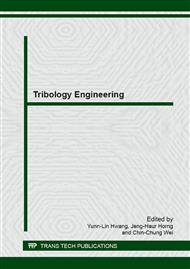p.135
p.141
p.147
p.152
p.162
p.168
p.174
p.179
p.184
Structural, Electrical, and Resistance Force Characteristics of Ga-In-Sn Eutectic Alloys
Abstract:
This work aims at investigating the electrical property and the friction force of Ga-In-Sn eutectic alloys. The performance of the alloys is increasingly needed on conducting lubricant. Resistance force dependence of normal force was examined by atomic force microscopy, and the results showed that Ga65In21Sn14 had the highest friction coefficient of 3.07 and Ga80In13Sn7 had a lowest friction coefficient of 1.46. Electrical resistivity of the studied eutectic alloy was from 25.9 to 27.7 μΩcm at 25°C. Accordingly, the electrical resistivity as a function of temperature revealed a temperature coefficient of ranging from 12.67 ✕10-3 °C-1 to 4.94 ✕10-3 °C-1. High thermally stable and wetting capability make the studied Ga-In-Sn alloys can potentially be used as a conducting lubricant.
Info:
Periodical:
Pages:
162-167
Citation:
Online since:
April 2015
Authors:
Price:
Сopyright:
© 2015 Trans Tech Publications Ltd. All Rights Reserved
Share:
Citation:


